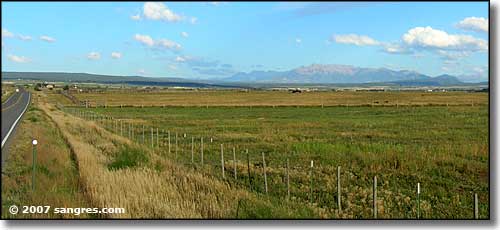
Unaweep-Tabeguache Scenic Byway
Naturita to Norwood

Naturita Canyon
While the townsite of Naturita is pretty lush, heading southeast out of town and up Naturita Canyon on the Unaweep-Tabeguache Scenic Byway is going into dry country. Once you reach the end of the canyon and head out over the flat park area where Norwood is, the countryside gets pretty green again. This is another big farming and cattle and horse ranch area, limited by the walls of the river canyons that interlace the area. Lots of big views.
European history in this area didn't legally begin until 1881 when the US Government forced the Weminuche Utes back onto the Ute Mountain Ute Reservation. However, part of the problems that forced the reduction in lands previously granted to the Utes took place in this area. There was a large wave of mineral prospectors who came through with no respect for the Ute boundaries. Then came a wave of farmers and ranchers who saw a lot of gorgeous countryside perfect for fulfilling their dreams on, but it was part of the Ute Reservation. While it was usually the European invaders who started the shooting, in the end the Utes were pushed back onto the least desirable lands of their original homelands and the invaders grabbed the rest.
Most of the roads we use today in that area of Colorado west of the plains, follow old freightwagon routes established in the gold mining days. Those routes followed the original prospectors trails, which followed old Ute hunting and traveling trails. The road I followed from Naturita to Placerville is one of those old Ute routes. The prospectors and freighters built it up in their journeys between Telluride and early gold strikes down the San Miguel River Valley to the northwest. During World War II the road was built up even more as the US Government pushed for more radium, vanadium and uranium mining between Uravan and Vancorum (northwest of Naturita). The uranium market collapsed in the 1950's and the feds shut down the last uranium ore milling facitility in 1983. This has been primarily a tourist road since then.
I stayed at the Back Narrows Inn in Norwood. It was built in 1898 and had been open ever since. The interior of the building has been kept as much in the original form and materials as possible by the owners. (I think it got its' name because the back of the building seems to be a bit narrower than the front.) It might have been the last available room in Norwood. Sitting over dinner in the Inn I talked to a few folks who told me there was a lot of oil or gas drilling going on around Norwood, that's why there were no rooms.

More of Naturita Canyon

Outside of Norwood

Looking south near Norwood, Lone Cone on the right

Looking northwest just out of Norwood, the San Miguel Mountains in the distance
